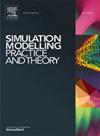岩石爆破损伤模拟构成模型的改进与性能分析
IF 3.5
2区 计算机科学
Q2 COMPUTER SCIENCE, INTERDISCIPLINARY APPLICATIONS
引用次数: 0
摘要
本文通过对单孔爆破和预裂爆破的一系列数值模拟,分析了 Riedel-Hiermaier-Thomal (RHT) 和 Holmquist-Johnson-Cook (HJC) 构造模型在模拟不同原位应力环境下岩石爆破裂纹扩展方面的性能差异。首先,通过力学实验确定了花岗岩的 RHT 模型参数。然后,通过引入失效准则对传统的 HJC 模型进行了改进,并验证了上述两种模型在模拟爆破裂缝中的实用性。最后,分析了这两种模型在模拟深部岩石爆破裂缝时的性能差异。结果表明,改进后的 HJC 模型与 RHT 模型在表征浅层岩石爆破裂缝方面具有一致性。随着埋深的增加,RHT 模型可以准确模拟不同原位应力条件下整个爆破区域的裂缝扩展,而改进型 HJC 模型只能模拟爆破井产生的破碎带。此外,改进型 HJC 模型的通用性较差,因为特定的失效准则无法适用于多种情况。这些发现可为深部岩石爆破模拟提供有价值的参考。本文章由计算机程序翻译,如有差异,请以英文原文为准。
Improvement and performance analysis of constitutive model for rock blasting damage simulation
Through a series of numerical simulations on single-hole blasting and presplit blasting, this paper analyzed the performance differences of the Riedel-Hiermaier-Thomal (RHT) and Holmquist-Johnson-Cook (HJC) constitutive models in simulating the blasting crack propagation of rock under different in-situ stress environments. Firstly, the RHT model parameters for granite were determined through mechanical experiments. Then, the traditional HJC model was improved by introducing failure criterion, and the practicability of the above two models in simulating blasting cracks was verified. Finally, the performance differences between these two models were analyzed in simulating blasting cracks of deep rocks. The results indicate that the improved HJC model is consistent with the RHT model in characterizing the blasting cracks of shallow rock. As the burial depth increases, the RHT model can accurately simulate the propagation of cracks in the entire blasting area under different in-situ stress conditions, while the improved HJC model can only simulate the crushed zone generated by blasting well. In addition, the improved HJC model behaves poorly in terms of general applicability because the specific failure criterion cannot be applied to multiple scenarios. These findings can offer valuable references to deep rock blasting simulations.
求助全文
通过发布文献求助,成功后即可免费获取论文全文。
去求助
来源期刊

Simulation Modelling Practice and Theory
工程技术-计算机:跨学科应用
CiteScore
9.80
自引率
4.80%
发文量
142
审稿时长
21 days
期刊介绍:
The journal Simulation Modelling Practice and Theory provides a forum for original, high-quality papers dealing with any aspect of systems simulation and modelling.
The journal aims at being a reference and a powerful tool to all those professionally active and/or interested in the methods and applications of simulation. Submitted papers will be peer reviewed and must significantly contribute to modelling and simulation in general or use modelling and simulation in application areas.
Paper submission is solicited on:
• theoretical aspects of modelling and simulation including formal modelling, model-checking, random number generators, sensitivity analysis, variance reduction techniques, experimental design, meta-modelling, methods and algorithms for validation and verification, selection and comparison procedures etc.;
• methodology and application of modelling and simulation in any area, including computer systems, networks, real-time and embedded systems, mobile and intelligent agents, manufacturing and transportation systems, management, engineering, biomedical engineering, economics, ecology and environment, education, transaction handling, etc.;
• simulation languages and environments including those, specific to distributed computing, grid computing, high performance computers or computer networks, etc.;
• distributed and real-time simulation, simulation interoperability;
• tools for high performance computing simulation, including dedicated architectures and parallel computing.
 求助内容:
求助内容: 应助结果提醒方式:
应助结果提醒方式:


